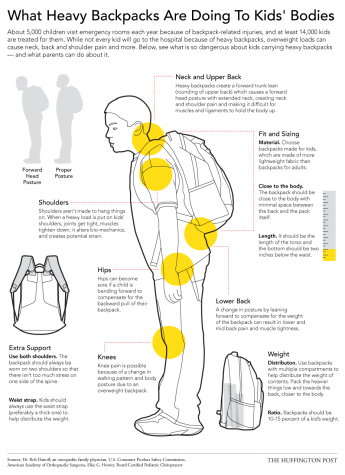Backpack Issues Weigh on Students
April 4, 2016
Here are some things that weigh 40 lbs.:
-a 15-foot canoe
-a 3-year-old child
-an average human leg
Sound like a lot to carry around school all day. Well, many students are carrying things that weigh just as much — on their back.
“I weighed my backpack and saw it was almost 40 lbs.,” Sophomore Cole Armstrong said.
He is not alone According to the U.S. Consumer Product Safety Commission, at least 14,000 students are treated for backpack-related injuries every year. Children and teens don’t realize the amount of damage being done to their backs every day by hauling around all of their books for long periods of time.
School nurse Mrs. Diane Nolte sees the problem everyday in students who go down to the nurse’s office — some complaining about back pain.
“When students come here, it’s hard not to notice how heavy their bags look,” she said.
A backpack should be 10-15 percent of the student’s body weight, or 25 pounds — whichever one is the smallest amount of weight, said Dr. Karen Carpenter of First Choice Chiropractic in Emmaus. Any more than that can start to cause problems, she said.
A backpack should be 10-15 percent of the student’s body weight, or 25 pounds
— Chiropractor Dr. Karen Carpenter
She also said backpacks should also not be hanging lower than a student’s waist. Hanging any lower causes unnecessary compression to the spine.
LONG-TERM INJURIES
Students may think they don’t need to worry about back issues because they’re still young, but if they don’t take precautions, they can end up with serious problems, says Carpenter.
“It doesn’t matter whether you’re really active or inactive,” she says. “It doesn’t change that amount you should be carrying.”
Heavy bags can compress a person’s spine — which leads to injuries such as arthritis and bulging discs, Dr. Carpenter said.
Bulging discs are one of the most common injuries that can be received through spine compression. Also known as slipped discs or protruding discs, they are injuries in which a rubbery disk between a person’s spinal bones is pressing against nerves, which cause pain.
Another common issue is degenerative disc disease, Dr. Carpenter said. This is a disease with a collection of symptoms such as pain, weakness, and numbness due to a degenerated disc in a person’s spine. The spine acts as a foundation of the skeletal system and if taken care of poorly, can result in a person’s range of movement becoming limited.
“You only have one spine for the whole duration of your life,” Dr. Carpenter said. “It can’t be replaced, so you need to take care of it.”
The weight of the bags hanging off of students’ shoulders also causes extremely poor posture, known as forward head posture, according to Drs. Rob Danoff and Elise Hewitt, quoted in an article in huffingtonpost.com. Forward head posture causes a person’s neck to extend more, which creates shoulder and neck pain and stiffness. Lower and mid back pain and tense muscles also can occur.
This bad posture can also make a student’s walking pattern different in order to cope and even out the amount of weight on their back, according to the huffingtonpost.com article. This walking pattern can lead to sore hips and knee pain. All of the strain being put on the student’s body will inevitably end up fatiguing the muscles. This can lead to an increased risk of further injury.
SOLUTIONS
In order to prevent these injuries from arising as often in students, some habits have to change.
-Since weight distribution is what’s causing most of the problems, both shoulder straps must be in use, not just one, Dr. Carpenter said.
-Most backpack styles also come with a strap that clips around the person’s waist to keep it up against their back. Many choose to ignore that strap in particular because of how it may look while worn, but it makes a big difference, Carpenter said. It helps to distribute the weight onto the hip bones instead of the shoulders.
-Finding the perfect backpack style to support one’s back is also key, although that can prove to be difficult. A lot of them focus more on looks more than what’s actually important: support and padding.
“The styles and new trends of backpacks have absolutely no back support and students often have their bags hanging off one shoulder,” Nurse Nolte said.
-Another habit that students will have to change is the actual amount of weight on their backs. This can be accomplished all by organization. It’s important to clean out bags constantly, Dr. Carpenter said.
“That means every few weeks, take out all papers and sort out what’s needed and what can be either thrown out or filed away,” she said.
Once the books and folders are cleared of unnecessary bulk, it’s best to store them back in the backpack with the heaviest load closest to the individual’s back, she said. This distributes the weight so that the bag isn’t hanging down as much.
If a student is feeling discomfort due to their backpacks even after lightening their load, they should speak with their doctor and go from there. It’s better to be safe than sorry, especially when something so irreplaceable is at risk.

